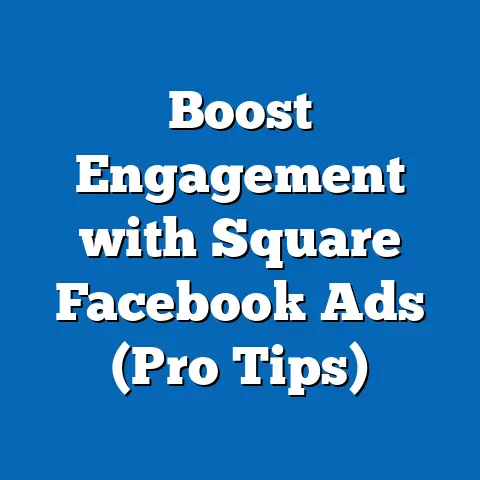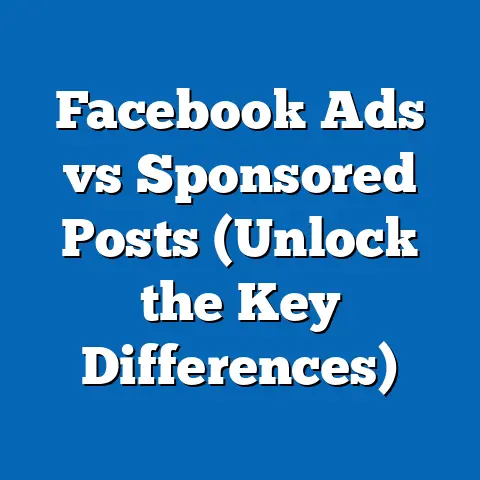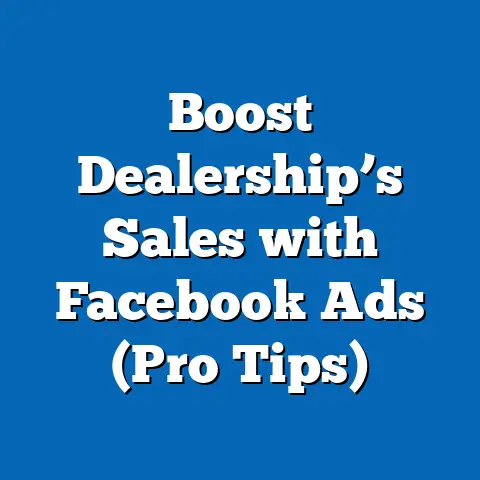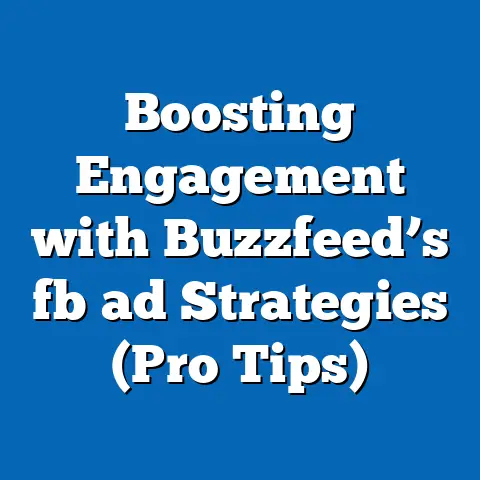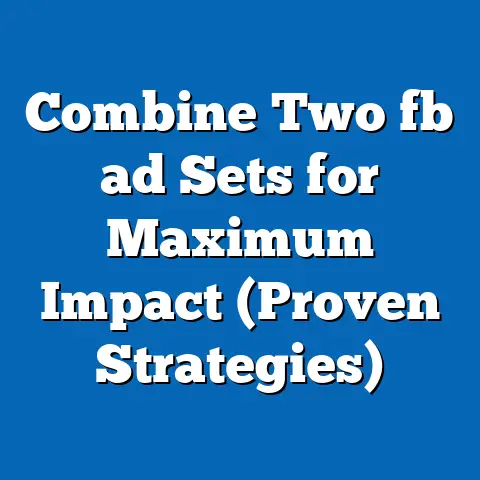How Facebook Makes Billions from Ads (Behind-the-Scenes Insights)
Ever watched one of those home renovation shows where a dilapidated house is transformed into a stunning dream home? The process is fascinating, right? It’s not just about slapping on some paint and calling it a day. It’s about careful planning, strategic execution, and a deep understanding of the space and its potential. Facebook’s advertising model is a lot like that. It’s taken the “dilapidated” space of user data and engagement and, through meticulous craftsmanship, transformed it into a billion-dollar revenue-generating machine.
I’ve spent years working with Facebook ads, and what continues to amaze me is the sheer complexity and sophistication of their system. It’s not just about throwing ads out there and hoping something sticks. It’s about understanding the platform’s inner workings, leveraging its data, and constantly adapting to the ever-changing landscape. In this article, I’m going to pull back the curtain and give you a behind-the-scenes look at how Facebook makes billions from ads. We’ll explore the foundation of their model, the mechanics of ad placement, the role of data analytics, the impact of privacy regulations, and even peek into the future of Facebook advertising.
Section 1: The Foundation of Facebook’s Advertising Model
The foundation of Facebook’s advertising empire rests on a few key pillars. Without these, the whole thing would crumble. Let’s take a look:
-
The User Base: First and foremost, you need an audience. And boy, does Facebook have an audience! With billions of active users worldwide, Facebook boasts a massive and diverse user base. These users span a wide range of demographics, interests, and behaviors, making it a prime advertising space for businesses targeting virtually any niche. It’s not just the sheer size; it’s the engagement. People are actively using Facebook, sharing their lives, connecting with friends and family, and consuming content. This constant engagement means there are ample opportunities to reach them with relevant ads.
-
Data Collection: The real magic happens behind the scenes with data collection. Facebook is a data-collecting machine. Every like, share, comment, post, and even the time you spend hovering over a particular piece of content is meticulously tracked. This data is then used to create detailed user profiles, painting a comprehensive picture of each individual’s interests, preferences, and habits. Think of it like building a detailed customer persona for every single user on the platform.
I remember one client I worked with who was initially skeptical about the level of targeting Facebook offered. He ran a small, niche online store selling handcrafted leather goods. He thought Facebook was only good for reaching a broad audience. But after we dug into the targeting options, we were able to pinpoint users who were not only interested in leather goods but also in specific types of crafts, vintage fashion, and even certain geographical locations known for artisanal workshops. The results were astounding, with a significantly higher conversion rate than he’d ever seen before.
-
Targeted Advertising: This is where all that data collection pays off. Targeted advertising is the process of delivering ads to specific groups of people based on their demographic information, interests, and behaviors. This allows advertisers to reach the right people with the right message at the right time, maximizing the effectiveness of their campaigns. Instead of casting a wide net and hoping to catch a few fish, targeted advertising allows you to use a spear and go after the exact fish you’re looking for.
Targeted advertising is essential because it increases the relevance of ads to users. When ads are relevant, users are more likely to engage with them, leading to higher click-through rates, lower costs, and ultimately, better results for advertisers. It’s a win-win situation. Users see ads that are actually interesting to them, and advertisers reach an audience that is more likely to convert.
The User Base: First and foremost, you need an audience. And boy, does Facebook have an audience! With billions of active users worldwide, Facebook boasts a massive and diverse user base. These users span a wide range of demographics, interests, and behaviors, making it a prime advertising space for businesses targeting virtually any niche. It’s not just the sheer size; it’s the engagement. People are actively using Facebook, sharing their lives, connecting with friends and family, and consuming content. This constant engagement means there are ample opportunities to reach them with relevant ads.
Data Collection: The real magic happens behind the scenes with data collection. Facebook is a data-collecting machine. Every like, share, comment, post, and even the time you spend hovering over a particular piece of content is meticulously tracked. This data is then used to create detailed user profiles, painting a comprehensive picture of each individual’s interests, preferences, and habits. Think of it like building a detailed customer persona for every single user on the platform.
I remember one client I worked with who was initially skeptical about the level of targeting Facebook offered. He ran a small, niche online store selling handcrafted leather goods. He thought Facebook was only good for reaching a broad audience. But after we dug into the targeting options, we were able to pinpoint users who were not only interested in leather goods but also in specific types of crafts, vintage fashion, and even certain geographical locations known for artisanal workshops. The results were astounding, with a significantly higher conversion rate than he’d ever seen before.
Targeted Advertising: This is where all that data collection pays off. Targeted advertising is the process of delivering ads to specific groups of people based on their demographic information, interests, and behaviors. This allows advertisers to reach the right people with the right message at the right time, maximizing the effectiveness of their campaigns. Instead of casting a wide net and hoping to catch a few fish, targeted advertising allows you to use a spear and go after the exact fish you’re looking for.
Targeted advertising is essential because it increases the relevance of ads to users. When ads are relevant, users are more likely to engage with them, leading to higher click-through rates, lower costs, and ultimately, better results for advertisers. It’s a win-win situation. Users see ads that are actually interesting to them, and advertisers reach an audience that is more likely to convert.
Takeaway: Facebook’s advertising model is built on a foundation of a massive, engaged user base, sophisticated data collection, and highly targeted advertising capabilities. This combination allows them to deliver relevant ads to the right people, driving results for advertisers and generating billions in revenue.
Section 2: The Mechanics of Ad Placement
Now that we’ve laid the groundwork, let’s dive into the actual mechanics of how Facebook serves ads to users. It’s not as simple as just picking a target audience and hitting “go.” There’s a complex system at play, involving auctions, algorithms, and various ad formats.
-
The Auction Process: Facebook ad placements are determined through an auction process. Advertisers bid for ad space, specifying how much they’re willing to pay to reach a particular audience. The higher the bid, the more likely the ad is to be shown. However, it’s not just about the highest bid. Facebook also considers the quality and relevance of the ad when determining which ads to show.
I’ve seen firsthand how a well-crafted ad with a lower bid can outperform a poorly designed ad with a higher bid. It’s all about creating an ad that resonates with the target audience and provides value. Facebook’s algorithm rewards ads that users find engaging, giving them more visibility and lowering the overall cost.
-
The Algorithm’s Role: Facebook’s algorithm plays a crucial role in determining which ads are shown to which users. The algorithm analyzes various factors, including the user’s past behavior, the relevance of the ad, and the advertiser’s bid, to determine the optimal ad to display. This is where the concept of the “relevance score” comes into play.
The relevance score is a metric that Facebook uses to assess the quality and relevance of an ad. The higher the relevance score, the more likely the ad is to be shown to users and the lower the cost per click. Factors that influence the relevance score include the ad’s click-through rate, engagement rate, and overall feedback from users. Facebook wants to provide a positive experience for its users, and that means showing them ads that are actually relevant and interesting.
-
Ad Formats: Facebook offers a variety of ad formats to cater to different campaign goals and target audiences. These include:
- Image Ads: Simple and effective for showcasing products or services.
- Video Ads: Engaging and versatile for telling stories and capturing attention.
- Carousel Ads: Allow users to scroll through multiple images or videos in a single ad unit.
- Collection Ads: Designed for e-commerce businesses to showcase products in a visually appealing format.
- Instant Experiences: Full-screen, interactive experiences that load quickly on mobile devices.
Facebook constantly optimizes these ad formats to improve their effectiveness. They’re always experimenting with new features and layouts to enhance user engagement and drive results for advertisers.
The Auction Process: Facebook ad placements are determined through an auction process. Advertisers bid for ad space, specifying how much they’re willing to pay to reach a particular audience. The higher the bid, the more likely the ad is to be shown. However, it’s not just about the highest bid. Facebook also considers the quality and relevance of the ad when determining which ads to show.
I’ve seen firsthand how a well-crafted ad with a lower bid can outperform a poorly designed ad with a higher bid. It’s all about creating an ad that resonates with the target audience and provides value. Facebook’s algorithm rewards ads that users find engaging, giving them more visibility and lowering the overall cost.
The Algorithm’s Role: Facebook’s algorithm plays a crucial role in determining which ads are shown to which users. The algorithm analyzes various factors, including the user’s past behavior, the relevance of the ad, and the advertiser’s bid, to determine the optimal ad to display. This is where the concept of the “relevance score” comes into play.
The relevance score is a metric that Facebook uses to assess the quality and relevance of an ad. The higher the relevance score, the more likely the ad is to be shown to users and the lower the cost per click. Factors that influence the relevance score include the ad’s click-through rate, engagement rate, and overall feedback from users. Facebook wants to provide a positive experience for its users, and that means showing them ads that are actually relevant and interesting.
Ad Formats: Facebook offers a variety of ad formats to cater to different campaign goals and target audiences. These include:
- Image Ads: Simple and effective for showcasing products or services.
- Video Ads: Engaging and versatile for telling stories and capturing attention.
- Carousel Ads: Allow users to scroll through multiple images or videos in a single ad unit.
- Collection Ads: Designed for e-commerce businesses to showcase products in a visually appealing format.
- Instant Experiences: Full-screen, interactive experiences that load quickly on mobile devices.
Facebook constantly optimizes these ad formats to improve their effectiveness. They’re always experimenting with new features and layouts to enhance user engagement and drive results for advertisers.
Takeaway: Facebook’s ad placement system is a complex interplay of auctions, algorithms, and ad formats. Understanding how these elements work together is crucial for creating effective advertising campaigns that reach the right people and achieve the desired results.
Section 3: The Role of Data Analytics
Facebook’s advertising model wouldn’t be nearly as effective without the power of data analytics. Data analytics allows advertisers to track the performance of their campaigns, gain insights into user behavior, and refine their strategies for optimal results.
-
Facebook Insights and Ads Manager: Facebook provides a suite of tools that advertisers can use to track their performance and gain insights into user behavior. Facebook Insights provides demographic information about your audience, as well as data on their engagement with your content. Ads Manager allows you to track the performance of your advertising campaigns, including metrics like reach, impressions, clicks, and conversions.
I’ve spent countless hours poring over data in Ads Manager, trying to decipher patterns and identify opportunities for improvement. It’s like being a detective, piecing together clues to solve a mystery. What’s working? What’s not? Who are the people responding to my ads? What are their interests? The answers to these questions are all hidden within the data, waiting to be discovered.
-
Case Studies: There are countless examples of successful advertising campaigns that have leveraged Facebook’s analytics to achieve remarkable results. For instance, a clothing retailer might use Facebook Insights to discover that their target audience is particularly interested in sustainable fashion. They could then create an ad campaign showcasing their eco-friendly clothing line, targeting users who have expressed an interest in sustainability.
I once worked with a local restaurant that was struggling to attract new customers. We used Facebook Ads Manager to target users who lived within a certain radius of the restaurant and had expressed an interest in food and dining. We also tracked the performance of our ads, paying close attention to metrics like click-through rate and conversion rate. We discovered that certain ad creatives were performing much better than others, so we focused our efforts on those creatives. As a result, we were able to significantly increase the number of new customers visiting the restaurant.
-
A/B Testing: A/B testing is a crucial component of any successful Facebook advertising campaign. A/B testing involves creating two or more versions of an ad and testing them against each other to see which performs better. This allows advertisers to fine-tune their approaches and optimize their campaigns for maximum effectiveness.
I always encourage my clients to embrace A/B testing. It’s the best way to learn what resonates with your audience and to identify areas for improvement. You can test different headlines, images, call-to-actions, and even targeting options to see which combinations yield the best results.
Facebook Insights and Ads Manager: Facebook provides a suite of tools that advertisers can use to track their performance and gain insights into user behavior. Facebook Insights provides demographic information about your audience, as well as data on their engagement with your content. Ads Manager allows you to track the performance of your advertising campaigns, including metrics like reach, impressions, clicks, and conversions.
I’ve spent countless hours poring over data in Ads Manager, trying to decipher patterns and identify opportunities for improvement. It’s like being a detective, piecing together clues to solve a mystery. What’s working? What’s not? Who are the people responding to my ads? What are their interests? The answers to these questions are all hidden within the data, waiting to be discovered.
Case Studies: There are countless examples of successful advertising campaigns that have leveraged Facebook’s analytics to achieve remarkable results. For instance, a clothing retailer might use Facebook Insights to discover that their target audience is particularly interested in sustainable fashion. They could then create an ad campaign showcasing their eco-friendly clothing line, targeting users who have expressed an interest in sustainability.
I once worked with a local restaurant that was struggling to attract new customers. We used Facebook Ads Manager to target users who lived within a certain radius of the restaurant and had expressed an interest in food and dining. We also tracked the performance of our ads, paying close attention to metrics like click-through rate and conversion rate. We discovered that certain ad creatives were performing much better than others, so we focused our efforts on those creatives. As a result, we were able to significantly increase the number of new customers visiting the restaurant.
A/B Testing: A/B testing is a crucial component of any successful Facebook advertising campaign. A/B testing involves creating two or more versions of an ad and testing them against each other to see which performs better. This allows advertisers to fine-tune their approaches and optimize their campaigns for maximum effectiveness.
I always encourage my clients to embrace A/B testing. It’s the best way to learn what resonates with your audience and to identify areas for improvement. You can test different headlines, images, call-to-actions, and even targeting options to see which combinations yield the best results.
Takeaway: Data analytics is the engine that drives Facebook’s advertising model. By tracking performance, gaining insights into user behavior, and embracing A/B testing, advertisers can optimize their campaigns and achieve remarkable results.
Section 4: The Impact of Privacy Regulations
In recent years, privacy regulations like GDPR (General Data Protection Regulation) and CCPA (California Consumer Privacy Act) have had a significant impact on Facebook’s advertising model. These regulations have placed greater emphasis on user consent and data privacy, forcing Facebook to adapt its strategies.
-
Data Collection and User Consent: GDPR and CCPA have forced Facebook to be more transparent about its data collection practices and to obtain explicit consent from users before collecting and using their data for advertising purposes. This has led to changes in the way Facebook tracks user behavior and delivers targeted ads.
I’ve noticed a significant shift in the way Facebook handles user data since the implementation of GDPR. Users now have more control over their data and can opt out of certain types of tracking. This has made it more challenging for advertisers to target specific audiences, but it has also forced them to be more creative and strategic in their approaches.
-
Adapting to Compliance: Facebook has adapted its strategies to comply with these laws while still maximizing ad revenue. They’ve introduced new tools and features that allow users to control their ad preferences and to see why they’re being shown a particular ad. They’ve also invested in privacy-enhancing technologies that allow them to deliver targeted ads without compromising user privacy.
Facebook has made a concerted effort to strike a balance between user privacy and effective advertising. They understand that if they alienate their users with overly intrusive data collection practices, they risk losing them to other platforms.
-
The Balance Between Privacy and Advertising: Finding the right balance between user privacy and effective advertising is a constant challenge for Facebook. On the one hand, they need to protect user privacy and comply with regulations. On the other hand, they need to generate revenue from advertising to keep the platform free and accessible.
I believe that the future of Facebook advertising lies in finding innovative ways to deliver targeted ads without relying on overly intrusive data collection practices. This might involve using more contextual advertising, which targets users based on the content they’re currently viewing, rather than their past behavior. It might also involve using more privacy-preserving technologies, such as differential privacy, which adds noise to data to protect individual identities while still allowing for meaningful analysis.
Data Collection and User Consent: GDPR and CCPA have forced Facebook to be more transparent about its data collection practices and to obtain explicit consent from users before collecting and using their data for advertising purposes. This has led to changes in the way Facebook tracks user behavior and delivers targeted ads.
I’ve noticed a significant shift in the way Facebook handles user data since the implementation of GDPR. Users now have more control over their data and can opt out of certain types of tracking. This has made it more challenging for advertisers to target specific audiences, but it has also forced them to be more creative and strategic in their approaches.
Adapting to Compliance: Facebook has adapted its strategies to comply with these laws while still maximizing ad revenue. They’ve introduced new tools and features that allow users to control their ad preferences and to see why they’re being shown a particular ad. They’ve also invested in privacy-enhancing technologies that allow them to deliver targeted ads without compromising user privacy.
Facebook has made a concerted effort to strike a balance between user privacy and effective advertising. They understand that if they alienate their users with overly intrusive data collection practices, they risk losing them to other platforms.
The Balance Between Privacy and Advertising: Finding the right balance between user privacy and effective advertising is a constant challenge for Facebook. On the one hand, they need to protect user privacy and comply with regulations. On the other hand, they need to generate revenue from advertising to keep the platform free and accessible.
I believe that the future of Facebook advertising lies in finding innovative ways to deliver targeted ads without relying on overly intrusive data collection practices. This might involve using more contextual advertising, which targets users based on the content they’re currently viewing, rather than their past behavior. It might also involve using more privacy-preserving technologies, such as differential privacy, which adds noise to data to protect individual identities while still allowing for meaningful analysis.
Takeaway: Privacy regulations have had a significant impact on Facebook’s advertising model, forcing them to be more transparent about their data collection practices and to obtain explicit consent from users. Finding the right balance between user privacy and effective advertising is a constant challenge for Facebook, but it’s a challenge they must overcome to ensure the long-term sustainability of their platform.
Section 5: Future Trends in Facebook Advertising
The world of digital advertising is constantly evolving, and Facebook is no exception. As technology advances and user behavior changes, Facebook’s advertising strategy will undoubtedly adapt. Let’s take a look at some of the potential future trends:
-
Augmented Reality (AR) Ads: Augmented reality (AR) ads are an emerging trend that could revolutionize the way brands engage with consumers on Facebook. AR ads allow users to interact with virtual objects in the real world, creating immersive and engaging experiences.
I can imagine a future where you can try on clothes virtually using an AR ad on Facebook, or see how a piece of furniture would look in your living room before you buy it. The possibilities are endless. AR ads have the potential to be incredibly effective, as they offer a unique and engaging way to connect with consumers.
-
E-commerce Integration: Facebook is increasingly integrating e-commerce features into its platform, making it easier for users to buy products directly from their newsfeed. This trend is likely to continue in the future, with Facebook becoming a more prominent player in the e-commerce space.
I’ve seen firsthand how effective Facebook’s e-commerce integration can be. It allows businesses to streamline the purchasing process, making it easier for customers to buy their products. This can lead to higher conversion rates and increased sales.
-
AI-Driven Ad Personalization: Artificial intelligence (AI) is playing an increasingly important role in Facebook advertising. AI can be used to personalize ads based on individual user preferences, making them more relevant and engaging.
I believe that AI will be the key to unlocking the full potential of Facebook advertising. AI can analyze vast amounts of data to identify patterns and trends, allowing advertisers to create highly targeted and personalized ads that resonate with their audience.
-
Changes in User Behavior: As user behavior continues to evolve, Facebook will need to adapt its advertising strategy to remain relevant. For example, the rise of mobile devices has led to a shift towards shorter, more visually appealing ad formats.
I’m constantly monitoring changes in user behavior to see how they might impact my advertising campaigns. It’s important to stay ahead of the curve and to adapt your strategies accordingly.
Augmented Reality (AR) Ads: Augmented reality (AR) ads are an emerging trend that could revolutionize the way brands engage with consumers on Facebook. AR ads allow users to interact with virtual objects in the real world, creating immersive and engaging experiences.
I can imagine a future where you can try on clothes virtually using an AR ad on Facebook, or see how a piece of furniture would look in your living room before you buy it. The possibilities are endless. AR ads have the potential to be incredibly effective, as they offer a unique and engaging way to connect with consumers.
E-commerce Integration: Facebook is increasingly integrating e-commerce features into its platform, making it easier for users to buy products directly from their newsfeed. This trend is likely to continue in the future, with Facebook becoming a more prominent player in the e-commerce space.
I’ve seen firsthand how effective Facebook’s e-commerce integration can be. It allows businesses to streamline the purchasing process, making it easier for customers to buy their products. This can lead to higher conversion rates and increased sales.
AI-Driven Ad Personalization: Artificial intelligence (AI) is playing an increasingly important role in Facebook advertising. AI can be used to personalize ads based on individual user preferences, making them more relevant and engaging.
I believe that AI will be the key to unlocking the full potential of Facebook advertising. AI can analyze vast amounts of data to identify patterns and trends, allowing advertisers to create highly targeted and personalized ads that resonate with their audience.
Changes in User Behavior: As user behavior continues to evolve, Facebook will need to adapt its advertising strategy to remain relevant. For example, the rise of mobile devices has led to a shift towards shorter, more visually appealing ad formats.
I’m constantly monitoring changes in user behavior to see how they might impact my advertising campaigns. It’s important to stay ahead of the curve and to adapt your strategies accordingly.
Takeaway: The future of Facebook advertising is likely to be shaped by emerging trends like augmented reality ads, e-commerce integration, AI-driven ad personalization, and changes in user behavior. Advertisers who are able to adapt to these changes will be well-positioned to succeed on the platform.
Conclusion
So, how does Facebook make billions from ads? As we’ve explored, it’s a complex and multifaceted process. It’s about leveraging a massive and engaged user base, collecting vast amounts of data, delivering highly targeted ads, and constantly adapting to the ever-changing landscape of digital advertising.
Much like a well-executed home renovation project, Facebook’s advertising success is the result of strategic planning, innovative thinking, and a keen understanding of user behavior. It’s not just about throwing money at the problem and hoping something sticks. It’s about carefully crafting a strategy that aligns with your business goals and resonates with your target audience.
The future of advertising in the digital age is uncertain, but one thing is clear: Facebook will continue to play a major role. As technology advances and user behavior changes, Facebook will undoubtedly adapt its advertising strategy to remain relevant and effective. The key for advertisers is to stay informed, be adaptable, and embrace the power of data analytics.
The journey of understanding how Facebook makes billions from ads is a continuous learning experience. Just like a home renovation, there’s always something new to learn, something to improve, and something to adapt to. The key is to embrace the challenge and to never stop learning.

